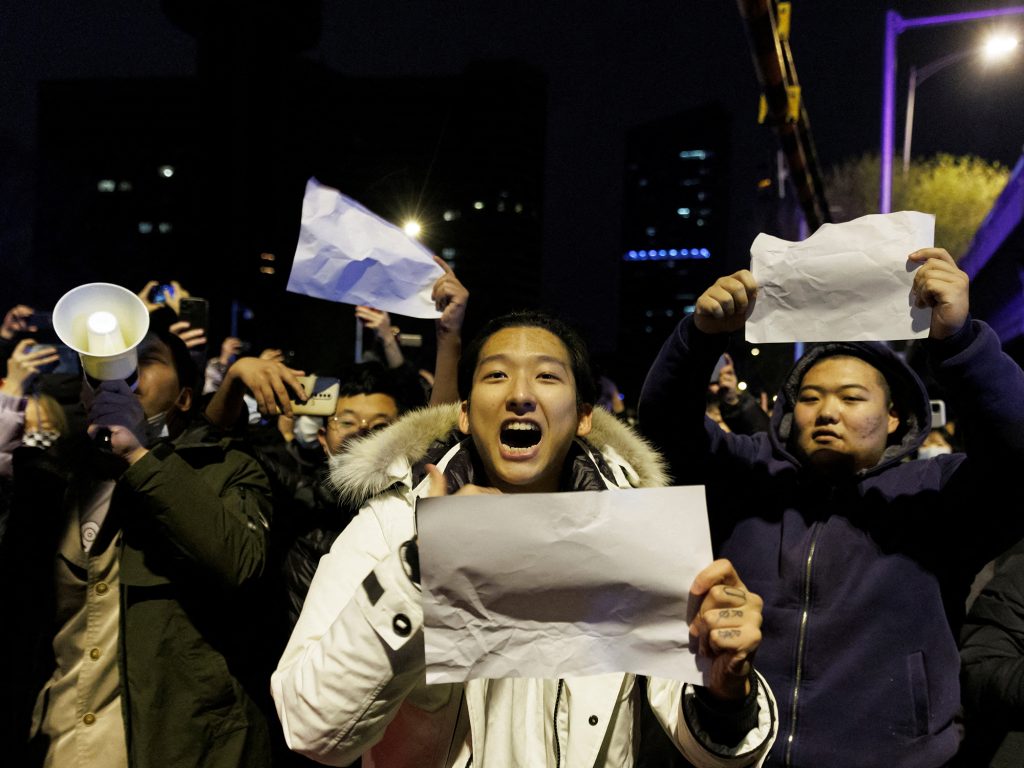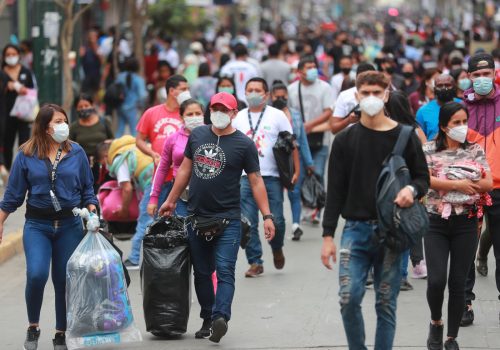For over a decade, the number of countries becoming more autocratic each year has eclipsed the number of countries democratizing, amounting to what some are calling the world’s third wave of ‘autocratization.’
There are several reasons why. In some cases, autocratic regimes have been able to deliver on short-term growth and prosperity. Autocratic leaders often are able to quickly implement policies and make decisions without extensive debate and consensus-building in their countries, which can lead to faster economic growth and greater efficiency. China is often the first country to come to mind; but other regimes such as Singapore (a one-party state) or the United Arab Emirates (an elective monarchy) have experienced rapid economic development in recent decades attributed in part to their ability to often implement policies without being slowed down by democratic processes.
But there’s now data that shows how the pillars of modern democracies relate to prosperity. Last month, the Atlantic Council hosted its first Freedom and Prosperity Research Conference, gathering scholars from around the world to present their data-based research on the relationship between prosperity and economic, political, and legal freedoms. While the scholars presented different opinions on that relationship, they came to a consensus that autocracies are making deliberate attempts to undermine the attractiveness of the democratic model worldwide. They argued that it will take voices from all regions to defend the democratic model.
“There’s a systemic challenge from autocracies to displace democracies as the leading form of governance,” said Damon Wilson, president and chief executive officer of the National Endowment for Democracy, in remarks given to kick off the conference. “We see this sharper repression… [and] the sharing of techniques across borders among autocrats [which are] helping cement kleptocratic rulers in countries around the world that are not serving the poor, that are not serving their people’s interests.”
The conference featured a rich discussion on how to better understand the relationship between liberal democracy, the rule of law, and true prosperity. Policymakers championing democracy in regions around the world should use the presented research to help turn the tide of autocratization in the years ahead. Several of the policy recommendations that came out are distilled below. All credit goes to the conference’s speakers and participants:
- Understand that freedom and prosperity are interconnected. One team led by Vladimir Fernandes Maciel used Granger causality tests to reveal that freedom and prosperity are not independent factors; rather, they are mutually reinforcing. This dynamic relationship creates a virtuous cycle, with each factor positively influencing the other. Another team, led by Benjamin Powell, looked specifically at economic freedom and concluded from their research that economic freedom is not only correlated with prosperity but is also a significant cause of it. According to those researchers, even a small increase in economic freedom of 3.5 points (according to the Atlantic Council’s Freedom and Prosperity Indexes) can result in gross-domestic-product growth of 6 to 8 percentage points over just five years.
- Customize policies for each country or region. Institutions and the rule of law play a critical role in driving prosperity. However, that relationship can vary greatly between regions. For that reason, policymakers must tailor their strategies for boosting prosperity to the unique economic landscape and needs of each country or region.
- Remain open to lessons from elsewhere in the world. The need to customize policies doesn’t mean that policymakers shouldn’t draw lessons from regional trends: For example, as Parth Shah explained, officials in India sometimes think of the country as “exceptional”—to the extent that they believe lessons from elsewhere in the world cannot help their own country. But, he argued, there are lessons for India to learn about the relationship between freedom and prosperity by examining how that relationship has played out across Southeast Asia and in other lower-middle-income countries.
- Promote diversity; it is essential to innovation. In the Western system, people with diverse backgrounds are more freely able to innovate, investors are more likely to take risks in supporting new technologies for the long term, and governments are more likely to have less-restrictive policies. This makes the Western system better suited for promoting innovation than the authoritarian model, in which policies are more restrictive and investors are more risk averse. Protecting the rule of law, free markets, and diversity—of people and of ideas—will be key to harnessing new technologies.
- Focus more on promoting democracy abroad. Most of the Arab Spring “failed,” said former Tunisian Minister of Foreign Affairs Khemaies Jhinaoui, because foreign countries provided insufficient aid and newly elected governments in the region focused on changing the way of life of people instead of addressing their real socio-economic problems. That led the youth and large segments of the population to become disillusioned with the process of transitioning to democracy. But there are still reasons for hope in the region, as the hunger for freedom and change continues to drive other parts of the population; those parts will need support from champions of democracy in the coming years.
- Look beyond indexes; use context in fighting democratic retrenchment. Although Mexico, for example, is rated as mostly free and mostly prosperous on the Atlantic Council’s Freedom and Prosperity Indexes, there are concerns that the country’s institutions, rule of law, and checks and balances are facing challenges. Vanessa Rubio-Marquez explained that while country indexes can be useful in identifying the factors that make a country free and prosperous, policymakers addressing democratic retrenchment in any country need to take a holistic approach that takes into account the country’s history and institutional foundations. And sometimes that means nipping democratic backsliding in the bud before it can show up on an index.
- Rally behind prosperity in Central and Eastern Europe. Russia’s invasion of Ukraine has drawn more international attention to Central and Eastern Europe. In responding to the war, the transatlantic community should also incorporate policies aimed at improving prosperity in the region as a whole. Those policies could include setting up economic partnerships based on a “flexibility plus conditionality” model in which partner countries invest in the region’s development—while leaving it up to the recipient countries to decide where exactly to direct these investments to improve prosperity.
- Empower the private sector to fuel economic growth and enhance prosperity. For example, Egypt is rated mostly unfree and mostly unprosperous in the Atlantic Council’s Freedom and Prosperity Indexes, but it has risen slightly on the United Nations Development Program’s Human Development Index. That modest progress is in part due to the government’s interventions which, although having improved some macroeconomic measures in Egypt, have largely restricted economic freedom and hindered private-sector growth. And its economy has proven highly vulnerable to external shocks such as Russia’s full-scale invasion of Ukraine.
Global progress toward democracy is not a given by any stretch. But democratic countries can help this process along by using the power of their example and drawing on relevant lessons from every corner of the globe. The connection between freedom and prosperity is real, but there’s no one right way to make it happen.
Yomna Gaafar is an assistant director at the Atlantic Council’s Freedom and Prosperity Center.
Joseph Lemoine is the deputy director of the Freedom and Prosperity Center.
Further reading
Thu, Feb 2, 2023
The top threats to the global economy and prosperity in 2023
Transcript By
At the Freedom and Prosperity Research Conference, Fisch talked about the biggest risks to the global economy and thus to poor and marginalized people worldwide.
Thu, Feb 2, 2023
Damon Wilson on selling democracy worldwide: It’ll take ‘voices from those in the developing world’
Transcript By
The National Endowment for Democracy president spoke about building the case that democracy is the best pathway for people, prosperity, and the poor.
Mon, Oct 17, 2022
The Freedom and Prosperity Indexes: How nations create prosperity that lasts
The Big Story By Dan Negrea, Matthew Kroenig
The inaugural Freedom and Prosperity Indexes show that democracies do indeed deliver. It’s time to reset the terms of the debate by letting the data do the talking. And the indexes have a lot to tell us. They reveal the most effective ways for governments to invest in their most important resource: their people.
Image: People hold white sheets of paper in protest over coronavirus disease restrictions after a vigil for the victims of a fire in Urumqi as outbreaks of COVID-19 continue, in Beijing, China, on November 28, 2022. Photo via REUTERS/Thomas Peter.



